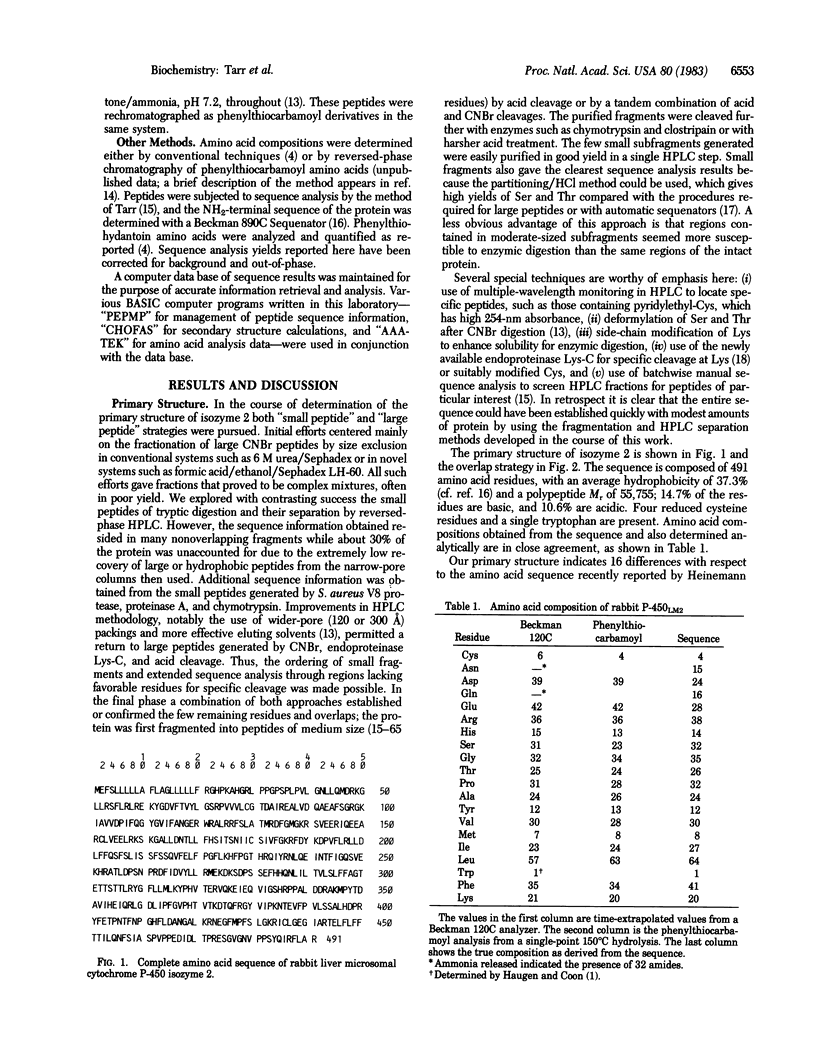Abstract
The complete amino acid sequence of phenobarbital-induced isozyme 2 of rabbit liver microsomal cytochrome P-450 (P-450LM2) is presented. The polypeptide consists of 491 residues with a calculated Mr of 55,755. The rabbit isozyme is 77% identical to the corresponding rat cytochrome, P-450b, as deduced from cDNA, with 96% of the hydrophobic, 88% of the anionic, and 83% of the cationic positions conserved. The secondary structure of isozyme 2 was predicted and a model was developed for the membrane topology of this cytochrome. Of the two highly conserved cysteinyl peptides in P-450LM2, P-450b, and bacterial P-450cam, we favor, on the basis of our model, the one nearer the NH2 terminus (Cys-152 in P-450LM2) as the source of the thiolate ligand to the heme iron atom. The recently reported sequence of the apparently identical protein [Heinemann, F. S. & Ozols, J. (1983) J. Biol. Chem. 258, 4195-4201] has two fewer residues and differs in 14 other amino acid assignments.
Full text
PDF




Selected References
These references are in PubMed. This may not be the complete list of references from this article.
- Armstrong R. N., Pinto-Coelho C., Ryan D. E., Thomas P. E., Levin W. On the glycosylation state of five rat hepatic microsomal cytochrome P-450 isozymes. J Biol Chem. 1983 Feb 25;258(4):2106–2108. [PubMed] [Google Scholar]
- Black S. D., Coon M. J. Structural features of liver microsomal NADPH-cytochrome P-450 reductase. Hydrophobic domain, hydrophilic domain, and connecting region. J Biol Chem. 1982 May 25;257(10):5929–5938. [PubMed] [Google Scholar]
- Black S. D., Tarr G. E., Coon M. J. Structural features of isozyme 2 of liver microsomal cytochrome P-450. Identification of a highly conserved cysteine-containing peptide. J Biol Chem. 1982 Dec 25;257(24):14616–14619. [PubMed] [Google Scholar]
- Chou P. Y., Fasman G. D. Empirical predictions of protein conformation. Annu Rev Biochem. 1978;47:251–276. doi: 10.1146/annurev.bi.47.070178.001343. [DOI] [PubMed] [Google Scholar]
- Cole P. W., Murakami K., Inagami T. Specificity and mechanism of clostripain catalysis. Biochemistry. 1971 Nov;10(23):4246–4252. doi: 10.1021/bi00799a015. [DOI] [PubMed] [Google Scholar]
- Drapeau G. R. Cleavage at glutamic acid with staphylococcal protease. Methods Enzymol. 1977;47:189–191. doi: 10.1016/0076-6879(77)47023-x. [DOI] [PubMed] [Google Scholar]
- Friedman M., Krull L. H., Cavins J. F. The chromatographic determination of cystine and cysteine residues in proteins as s-beta-(4-pyridylethyl)cysteine. J Biol Chem. 1970 Aug 10;245(15):3868–3871. [PubMed] [Google Scholar]
- Fujii-Kuriyama Y., Mizukami Y., Kawajiri K., Sogawa K., Muramatsu M. Primary structure of a cytochrome P-450: coding nucleotide sequence of phenobarbital-inducible cytochrome P-450 cDNA from rat liver. Proc Natl Acad Sci U S A. 1982 May;79(9):2793–2797. doi: 10.1073/pnas.79.9.2793. [DOI] [PMC free article] [PubMed] [Google Scholar]
- Gotoh O., Tagashira Y., Iizuka T., Fujii-Kuriyama Y. Structural characteristics of cytochrome P-450. Possible location of the heme-binding cysteine in determined amino-acid sequences. J Biochem. 1983 Mar;93(3):807–817. doi: 10.1093/jb/93.3.807. [DOI] [PubMed] [Google Scholar]
- Green N. M., Flanagan M. T. The prediction of the conformation of membrane proteins from the sequence of amino acids. Biochem J. 1976 Mar 1;153(3):729–732. doi: 10.1042/bj1530729. [DOI] [PMC free article] [PubMed] [Google Scholar]
- Haniu M., Armes L. G., Yasunobu K. T., Shastry B. A., Gunsalus I. C. Amino acid sequence of the Pseudomonas putida cytochrome P-450. II. Cyanogen bromide peptides, acid cleavage peptides, and the complete sequence. J Biol Chem. 1982 Nov 10;257(21):12664–12671. [PubMed] [Google Scholar]
- Haugen D. A., Armes L. G., Yasunobu K. T., Coon M. J. Amino-terminal sequence of phenobarbital-inducible cytochrome P-450 from rabbit liver microsomes: similarity to hydrophobic amino-terminal segments of preproteins. Biochem Biophys Res Commun. 1977 Aug 8;77(3):967–973. doi: 10.1016/s0006-291x(77)80072-7. [DOI] [PubMed] [Google Scholar]
- Haugen D. A., Coon M. J. Properties of electrophoretically homogeneous phenobarbital-inducible and beta-naphthoflavone-inducible forms of liver microsomal cytochrome P-450. J Biol Chem. 1976 Dec 25;251(24):7929–7939. [PubMed] [Google Scholar]
- Heinemann F. S., Ozols J. The complete amino acid sequence of rabbit phenobarbital-induced liver microsomal cytochrome P-450. J Biol Chem. 1983 Apr 10;258(7):4195–4201. [PubMed] [Google Scholar]
- Kanellis P., Romans A. Y., Johnson B. J., Kercret H., Chiovetti R., Jr, Allen T. M., Segrest J. P. Studies of synthetic peptide analogs of the amphipathic helix. Effect of charged amino acid residue topography on lipid affinity. J Biol Chem. 1980 Dec 10;255(23):11464–11472. [PubMed] [Google Scholar]
- Koop D. R., Morgan E. T., Tarr G. E., Coon M. J. Purification and characterization of a unique isozyme of cytochrome P-450 from liver microsomes of ethanol-treated rabbits. J Biol Chem. 1982 Jul 25;257(14):8472–8480. [PubMed] [Google Scholar]
- Sabatini D. D., Kreibich G., Morimoto T., Adesnik M. Mechanisms for the incorporation of proteins in membranes and organelles. J Cell Biol. 1982 Jan;92(1):1–22. doi: 10.1083/jcb.92.1.1. [DOI] [PMC free article] [PubMed] [Google Scholar]
- Tarr G. E., Crabb J. W. Reverse-phase high-performance liquid chromatography of hydrophobic proteins and fragments thereof. Anal Biochem. 1983 May;131(1):99–107. doi: 10.1016/0003-2697(83)90140-9. [DOI] [PubMed] [Google Scholar]
- Tarr G. E. Improved manual sequencing methods. Methods Enzymol. 1977;47:335–357. doi: 10.1016/0076-6879(77)47036-8. [DOI] [PubMed] [Google Scholar]
- von Heijne G. On the hydrophobic nature of signal sequences. Eur J Biochem. 1981 May 15;116(2):419–422. doi: 10.1111/j.1432-1033.1981.tb05351.x. [DOI] [PubMed] [Google Scholar]


